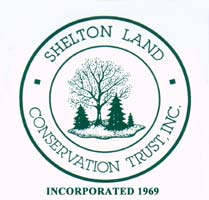|
Learn More About Shelton Trails
Trust members and the general public will have the opportunity to learn more about Shelton's recreation paths and trails at the June 27, 2001 general membership meeting. The 7:30 p.m. meeting that takes place at the Plumb Memorial Library, will highlight guest speaker, Mr. Thomas Harbinson, Chairman of the Trails Committee, and a member of the Conservation Commission. In addition to information about the existing trails, Tom will talk about the recent award Shelton received for its outstanding greenway program, and the Shelton Lakes Trail that received "Millennium Trail" status for the White House last year. Tom will also bring us up-to-date on the Shelton Lakes Recreation Path, that is currently in the planning stages. According to Tom, "...the trails become a focal point where people get together and enjoy hiking, biking, and jogging." The Shelton trail system will wind through more than 400 acres of peaceful wooded open spaces, featuring reservoirs, dams, farmland, vernal pools, and historical Indian caves. For a more in-depth perspective, please join us at the Plumb Memorial Library at 7:30 p.m. on June 27.
Farewell Bernie O'Dell Trust Officers, Board Members and members in attendance at the April meeting bid Godspeed and a fond farewell to long-time Board Member Bernard O'Dell. Bernie and his wife, Olive are relocating further upstate. One of the Land Trust's first active members, Bernie has served for many years on the Trust's Board of Directors, where he helped to shape policy, and provide helpful insight and direction for the Trust's many programs and activities. He and his wife are also very active with the Connecticut Audubon Society. In recognition of his many years of dedication , service and valuable contributions to the Trust and its members, President Mary Beth Banks presented Bernie with a special award. We wish Bernie and Olive our very best.
Become a Habitat Manager! Biologist Peter Picone of the CT Dept. of Environmental Protection proved to be a hit at the Trust's 1st general membership meeting of the year. At the April 25 meeting, held at the Plumb Memorial Library, Peter gave a brief historical review of how colonization, and human development has affected Connecticut's habitat and wildlife, and then outlined actions that today's residents can take to improve both. According to Peter, when the colonists first settled in Connecticut, approximately 90 to 95 % of its 3-million acres was forested. As colonization and agricultural activities continued, pastures replaced forested lands, so that by 1810, about 75% of CT was pasture or open fields. As a result of these activities, much of Connecticut's original wildlife was displaced, and in some cases disappeared completely. With the onset of the industrial revolution, people began leaving the farms, and moving into the cities, where they could easily obtain employment, in factories and businesses. Gradually, the pastoral land began reverting to the wooded landscape of former years, so that today, Connecticut is about 60% forested. Because approximately 80% of Connecticut land is privately owned, Peter and other Biologists at the DEP encourage home-owners to take an active role as a "Habitat Manager." "Actually," says Peter, "Anyone who has planted a tree, shrub, or even cut a lawn is already a Habitat Manager." Peter adds, "Many folks will put out a feeder, but forget about other needs. Like humans, animals need four basic things for survival, food, water, shelter, and space." To improve the wildlife habitat, and help provide for some of these needs Mr. Picone, and the DEP encourage the planting of native trees and shrubs. He points out that, What happens on each small plot of land, has a cumulative beneficial effect." Peter suggests beginning by drawing up a "plot-plan" of your property, identifying the existing trees, shrubs, and then determining how you might improve the habitat. The DEP has a number of brochures on local wild-life, and native plant species, and when and where they can best be utilized. RELATED RESOURCES Enhancing your Backyard Habitat for Wildlife A 27 page brochure - Describes the options of attracting wildlife to your backyard or small lot. Goes beyond traditional feeding by promoting landscapes that improve wildlife habitat. Discusses procedures for adding or modifying food sources, water and cover conditions. Shows how to assess habitat by using existing features and looking at seasonal availability of foods. Emphasizes the value of native plants for habitat enhancement. Contains examples of urban, suburban and rural lots that were improved for wildlife using the above techniques and management practices. Color plates of flora and fauna, landscape layouts. $5.00 Native Shrubs for Landscaping 40 page brochure - Describes the state's own assets for landscaping our yards and gardens. Fifty two native shrubs are discussed and depicted in 33 color plates. The full range of planting conditions, growth heights and flowering color of the shrubs shows there is little need for exotics. Includes a chapter on basic landscape design. Color plates of flora and fauna. $6.00 These and many other publications are available at the: Department of Environmental Protection
Environmental & Geographic Information Center
79 Elm Street
Hartford, CT 06106
SEPT. MEETING The Trust's next membership meeting will take place at 7:30 p.m. on September 26, at the Plumb Memorial Library. The Guest Speaker will be: Mr. Larry Russeau of the CT Dept. of Environmental Protection. Please mark your calendars, and plan to join us.
SHELTON LAND CONSERVATION TRUST, INC.
PO Box 2276 - Huntington Station
Shelton, CT 06484 | 
